by Dot Cannon
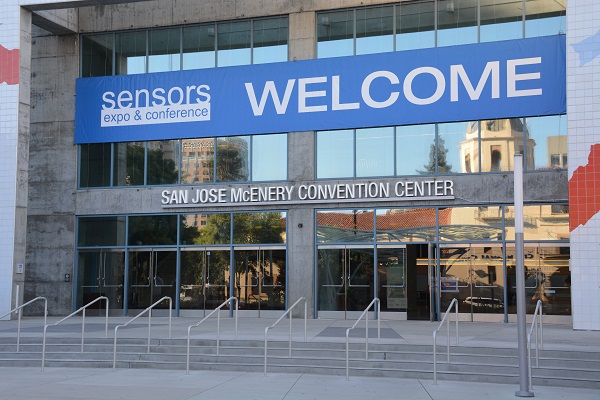
Sensors Expo banner welcomes attendees to Sensors Expo, 2018.
How might sensing technologies contribute to a healthier world, both during and after the pandemic?
According to the featured speakers during Sensors Innovation Week’s Day One, the answers to that question are myriad. They’re also evolving at an accelerated rate.
And as Sensors Expo and Conference and Fierce Electronics hosted this free virtual event, starting on Thursday morning, the subject was innovation.
Session One’s theme: “How Innovative Sensing Technology is Helping to Combat a Pandemic”.
Temperatures and the times
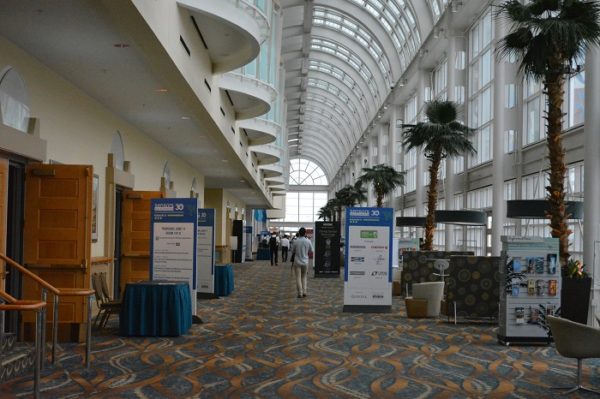
Sensors Espo and Conference, Long Beach Convention Center, 2015.
“The situation right now (has) changed…how we see the environment, the economy and the market,” said Yole Developpement Technology and Market Analyst Demetrios Damianos, in his Day One’keynote, “Thermal Imaging in the Battle Against COVID-19: Challenges and Opportunities”.
COVID-19, he said, had pushed innovators to develop new technologies in the areas of screening, diagnosis and disinfection.
In his presentation, Demetrios explored the ways thermal-imaging applications can work, in the area of fever detection.
“Of course, they’re not the only technology monitoring COVID-19, (but they’re the ones in which we have expertise),” he said.
Demetrios said accuracy presented a problem, when measuring individuals’ temperatures.
“There is a consensus that you must measure the temperature at the inner (corner) of the eye,” he explained.
Fever-screening thermal cameras, Demetrios said, had both strengths and weaknesses. One strength is rapid deployment. Accuracy is another, depending on the camera model.
Opportunities for development included privacy concerns, and a need to measure temperature from a distance, Demetrios added. In addition, the thermal-camera technique cannot currently distinguish whether a fever is a symptom of COVID-19 or has another cause.
But the technology is evolving rapidly.
“This is just a drop in the ocean of what is really out there,” he explained, showing a slide of several fever detection thermal cameras with the heading, “COVID-19 Induced Gold Rush”.
Demetrios said that, currently, “only a handful” of thermal cameras have FDA clearance. However, he added, given the current climate of necessity, the FDA is more open to approving new technology.
Putting technology into practice
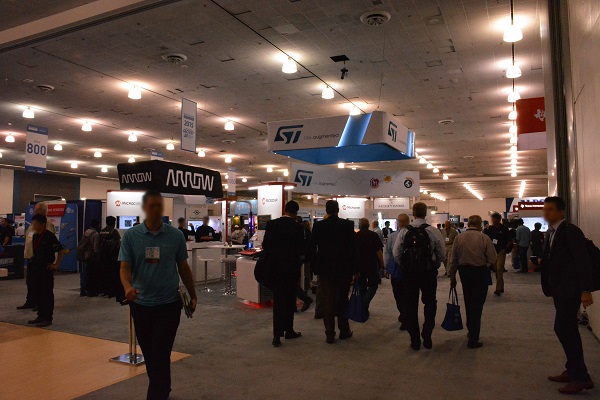
Attendees on Sensors Expo convention floor, 2016.
Next, Demetrios explored some current use cases for fever-screening thermal cameras. These included long-term use of ten- to 15-millimeter lens cameras for large areas, to measure the temperatures of groups of 30 to 50 people.
A second type of camera which could be deployed, he said, was a short-term “flexible” camera on a tripod. This would be for measuring individual temperatures, and could be used at building entrances, elevators and airport security.
“You can point to people and easily measure their temperature,” Demetrios explained.
He also detailed a possible “triage” procedure, for COVID-19 screening at airports.
How this works: the initial thermal camera screening would “flag” a passenger with a potential fever.
“People that present with an elevated temperature can be isolated, then (have their temperature measured) with a more accurate thermal gun,” he said.
In addition, there would be temperature-taking with a conventional thermometer. The passenger could then, potentially, be sent to disinfection rooms or tested for COVID-19. And a decision would reault, on whether that person could travel–or not.
Demetrios also projected the growth of thermal-imaging technology. In the future, he said, there would be the possibility that smartphones could include these temperature-measurement functions.
And the market is growing.
“In 2019, we expected the market of thermal-imaging cameras to be about four billion dollars,” Demetrios said.
“In 2020, we expect the market to explode, to be nearly seven billion.”
Going mobile–and spectral

Convention tracks listed for Sensors Expo and Conference, Long Beach, 2015.
Rapidity, accuracy and cost-effiectiveness, along with accessibility, were the areas which ams AG’s EVP and General Manager Jennifer Zhao referenced, in her keynote, “How Innovation Enables ams Spectral Sensing Technology To Improve COVID-19 Rapid Testing”.
“Currently, most of the tests are done by PCR (polymerase chain reaction methodology),” she began. “It’s sensitive but quite expensive.”
In addition, as her slide illustrated, PCR is not readily accessible at high volumes. This particular method of testing also involves numerous handling steps.
By contrast, Jennifer said, ams’ is developing digital lateral flow testing (LFT) units, using their proprietary spectral sensor technology.
“It’s very effective–ten times more sensitive (than) the human eye,” she said. “(With LFT), we can use Bluetooth to collect data.”
“Digital lateral flow is accurate and fast,” Jennifer explained. “You can get it in your home.”
Displaying a slide showing the ams spectral sensing platform, she said, “Within minutes you get this readout on mobile devices.”
Jennifer said ams had just partnered with Senova, several weeks ago. Currently, they’re developing the disposable lateral flow testing units.
“Mass production will start as soon as October,” she said.
Hands-free and healthy
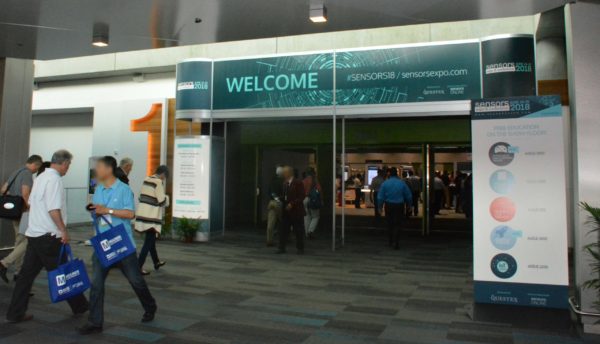
Entering the expo hall during Sensors Expo, 2018, San Jose.
“As we move forward, we must implement safety and cleanliness on a much larger scale,” said Omron Sensors and Product Manager Cary Horan.
In his presentation, “Touchless Sensors for a Safer Society”, Cary outlined the role sensor technologies may play in a post-COVID world. The need for safe distancing to stop the spread of the virus, he said, would lead to redesigning a number of products and current environments.
Presently, he pointed out, person-to-person bacteria transmission is facilitated by the way products work: “Switches, buttons, handles, and it’s obvious that in many industries, we are working with our hands,”
Concerns about virus transmission, Cary continued, could mean a new approach to home and building product development, “even after the coronavirus subsides”.
Cary focused on two areas in which touchless sensors could be “a mainstay for product design”: fever detection and touchless interfaces.
For fever detection, he said, thermal technology could read the basic health of people entering a building: guests, customers or employees.
(“Touchless thermal IR technology can take someone’s temperature from a foot and a half away,)” he said.
Meanwhile, for touchless interfaces, optical sensors could allow for cleaner, safer design of products such as elevator buttons. Currently, Cary said, the “touch” elevator buttons contain more bacteria than a toilet!
“Using optical sensor technology, we can implement designs for a safer and cleaner interface for users.”
A panel’s perspectives
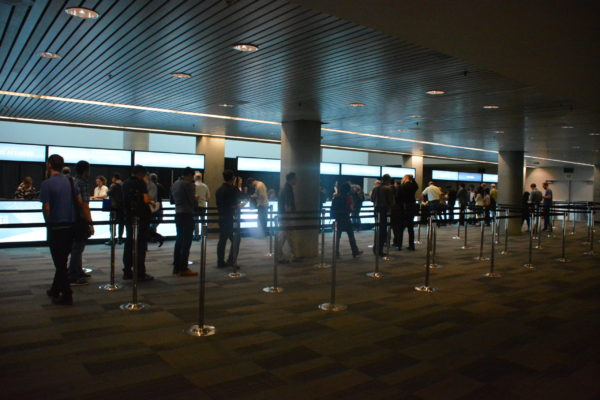
Attendees check in at registration desk for Sensors Expo, 2018.
The morning session concluded with a “Tech Talk” panel, with Fierce Electronics Editor Matt Hamblin serving as moderator.
Velentium CEO Dan Purvis, Infineon Head of Sensor Systems David Jones and ams AG Segment Health Marketing Director Filip Frederix explored the ways sensor technology is innovating in response to the pandemic.
“Our sensors specifically are for the consumer space,” David said. “(They mimic the functions of the human brain–microphones for voice, radar for vision, pressure sensing for touch, environmental sensing for smell.)”
“Essentially, how do we get back to a safe working environment? So we have a number of sensors that can do that.”
One of those sensor applications, he said, was a system of sensors that could count the number of people entering and leaving a building, for crowd control.
Meanwhile, Filip referenced the digital lateral flow test devices which ams is currently developing.
“The first product that we will bring to market, together with Senova, is an antibody test, to tell if you’re immune or not,” he said. “Normally, people have years (to develop this type of technology. Now, we have months.)”
Intensity and innovation
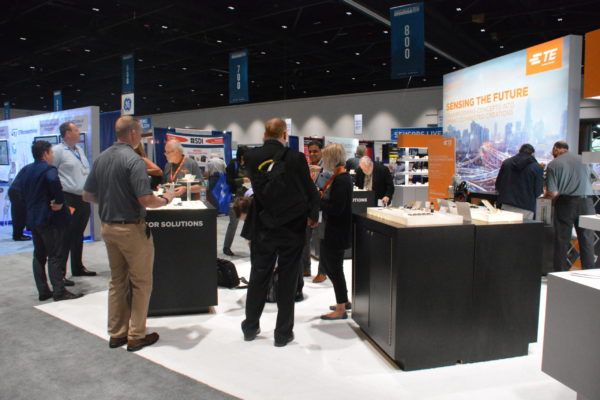
On the Sensors Expo floor, San Jose, 2019.
“The idea here, is to essentially take the world and make sure our systems are working, and working well,” Dan said.
Dan shared the story of Infineon’s work with a small Seattle startup, Ventec Life Systems. Ventec created the world’s first multi-function ventilator, with features including suction and cough assistance.
“We worked with them to take their production from 150 to 300 (units) a month,” Dan said.
“Then GM showed up, and the goal became to make 10,000 units a month (while assuring the units have the same standards of their original quality).”
Dan said he and his staff worked 18-hour days to manufacture the multi-function ventilators in the quantities needed. And now, they have a new project.
“(It’s) a patch you can wear on your forehead, and in the morning, you have a hospital-grade sleep study,” he explained. “We’ve been approached by people (asking) how this can be modified to COVID monitoring.
“It would be nice if you could put a patch on that person who has tested positive so (their) medical care team could (monitor) their vitals (including respiratory efforts, CO-2 and heart rates).”
“These will start to decline before you feel them…but sensors will pick up (the declines) so you know you need to get more care.
…”We can send data out via Bluetooth to a patient’s phone.”
A look forward
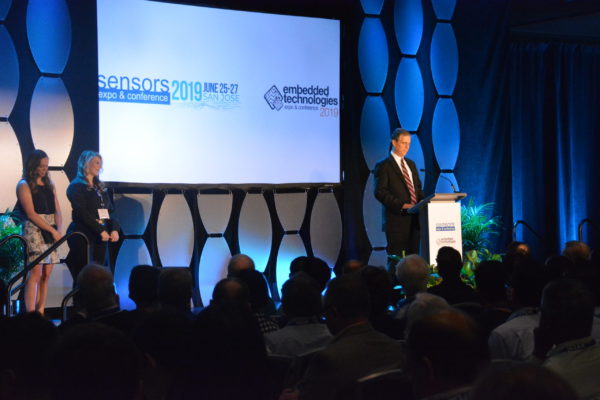
Awards for innovation, at Sensors Expo and Conference, San Jose, 2019.
“What happens with the products you’re making or developing, once COVID dissipates?” Matt asked the panel.
“Now we’re getting to the point of shrinking devices (like radar) into cell phones,” David answered. “Those technologies were viewed as cool innovations…but now you can apply them to a COVID world.
“Long-term, maybe there is a need for this type of (touch-free) technology, potentially creating a new need or new business.”
“The patch could be extended to new ways of getting information from the sensor,” Dan replied. “(There’s) the need to upgrade devices, not just patches.”
“A few months ago, nobody knew what an antibody antigen was, and now the whole world is talking about it,” Filip responded.
“Maybe in the future, people would like to test themselves at home (for flu and other home diagnostics).”
The first session of Sensors Innovation Week concluded. But much more was still to come, as “Sensors Innovation Week”‘s free virtual event continued.
Day Two of Sensors Innovation Week’s free virtual event starts Friday morning, July 17th, at 8:00 PDT, with a session entitled, “Hey Network, It’s Me, Sensor!”. Here’s the link for information.
